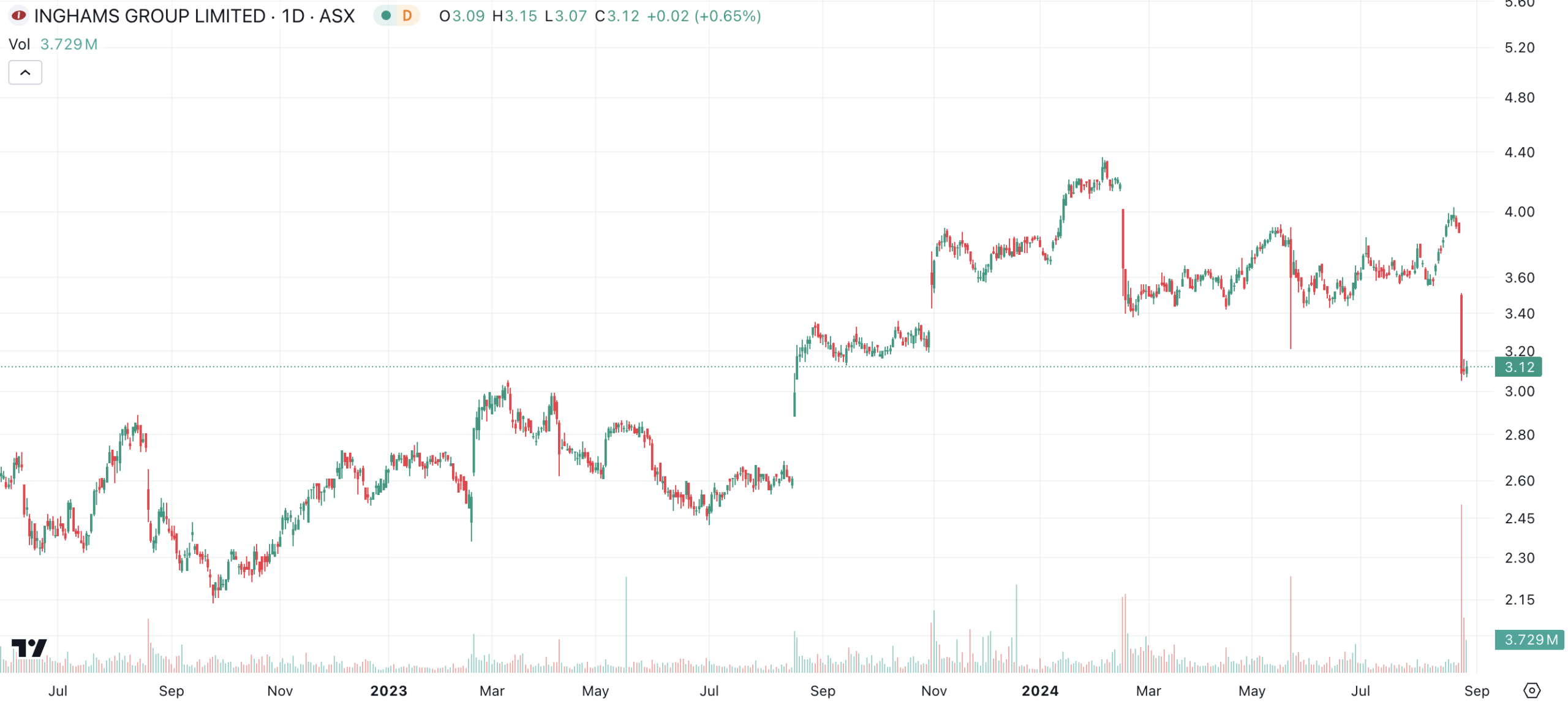Inghams (ASX:ING): Why the sudden volatility in the last 12 months?
![]() Nick Sundich, August 30, 2024
Nick Sundich, August 30, 2024
It has been a volatile year on the ASX and poultry company Inghams (ASX:ING) has not been an exception. Between late-October and mid-February, shares gained 30%, only to drop 20% upon its 1HY24 results. After 6 months of shares remaining stable, the full year results led to another 20% drop off. What’s been going on?
We think there is a lot to like about this company. It possesses many positive traits including a market-leading position, a long history and being in a recession-proof industry. But during these tough economic times, the company has not benefited as much as you might expect.
Introduction to Inghams (ASX:ING)
Inghams traces its origins back to 1918 and was a family-owned poultry business for several decades. Over time, it expanded into turkey and stockfeed and became a supplier towards major retail and quick service restaurants. Chicken is a popular food option because it is cheaper and healthier than red-meat. 70% of Australian families have it at least 3 times a week.
The company was sold to private equity giant TPS in 2013 and went public in 2016. TPS sold roughly half its stake at listing and gradually sold it down once the escrow period expired, exiting for good in 2020.
Inghams has not had the easiest life as a listed company even though its results have been far from terrible. However, it seemed a major corner was been turned in 2023.

Inghams (ASX:ING) share price chart, log scale (Source: TradingView)
An ‘eggcelent’ 2023, but ‘egghausting’ 2024
For much of the pandemic and its aftermath, the company battled higher input costs, including feed, packaging and freight, as well as supply chain challenges. And even though Inghams is the largest poultry company, its customers did have alternatives and its competitors had their own supply. It appeared those difficult times are over. In August 2023, the company released its FY23 results and it reported a $60.4m profit, up 72% in 12 months. This was in spite of Poultry Volumes going 0.4% backwards, because the company was able to pass on cost increases to its customers. It delivered a ROIC of 19%, up from 13.7% the year before.
Not even 3 months into FY23, the company gave a trading update for the first few months of the year that led it to upgrade its 1HY24 guidance. It told investors to expect for expecting a $65m statutory profit, a figure that would be up 7% from the year before. Of course, this was contingent on current trading levels being maintained. And the company expected results from the second half to be lower than the first half due to normal seasonality.
The company’s 1HY24 results looked OK at first glance with a profit of $63.4m, up 286.6% from the prior corresponding period, and sales increasing 2.2%. The company’s interim dividend was 20% more than the prior 6 months prior and 166.7% higher than 1HY24 – at 12c per share. However investors responded negatively due to certain warnings from the company including that there was cost growth as well as its growth in net debt by $83.4m to $345.9m and inventories increased by $31m. Inghams told investors that consumers were switching to retail products rather than QSR and out-of-home channel volumes.
Its full FY24 results similarly showed good headline figures, including a $101.5m profit, 68% above FY23. The company renewed its multi-year supply agreement with Woolworths and told shareholders it progressed or completed several important investments, including in its automation capabilities. But this paragraph seemingly made investors panic.

Source: Company
For FY25, it told investors that poultry volume growth would be between 1 and 3% lower than the year before, while EBITDA would be flat at best, 6% backwards at worse. ‘Consumer conditions in the near term are expected to remain challenging due to cost-of-living pressures, with inflation expected to remain elevated during FY24,’ the company said.
What we think Inghams is worth
The 11 analysts covering Inghams have a mean share price is $3.65, barely 16% above the current share price now, but it was a discount just a few days ago. Granted, there is a significant divergence of opinion with the lowest being $3.15 and the highest being $4.67. They share the company’s FY25 guidance for EBITDA ($447.1m to be exact as opposed to $463m the year before), as well as for flat revenue of $3.21bn. Will FY26 be better? Not from a revenue basis, with $3.27bn revenue and EBITDA backwards again at $437.5m. The company’s EPS line is expected to increase from 28c per share to 32c per share. FY27 is expected to be a better year with $3.33bn in revenue, $456.7m in EBITDA and $0.35 EPS.
These multiples place the company at just 10x P/E. For comparison’s sake, peer Bega Cheese (ASX:BGA) is 26x P/E for FY25. Obviously, there are risks with investing in Inghams supply chain issues, competition and potentially macroeconomic softness. Investors appear to think things won’t substantially improve for some months yet. But if they do recover quickly, Inghams is set for a much better next 8 years listed than its first 8.
What are the Best ASX Stocks to invest in right now?
Check our ASX stock buy/sell tips
Blog Categories
Get Our Top 5 ASX Stocks for FY25
Recent Posts
Apple’s iPhone Production in Focus: Is the Tariff Pause Enough to Ease the Pressure?
Apple, one of the largest and most influential tech companies in the world, is no stranger to the fluctuations of…
Why travel shares are getting slammed…and it is not for the reasons you may think
Just when ASX travel shares were out of the COVID-19 doldrums (in that some surpassed their pre-COVID highs), 2025 looks…
Capital Gains Tax on Stocks: Here’s what you need to know
Investors may be liable to pay Capital Gains Tax on Stocks, but may not know the nuances of how it…



